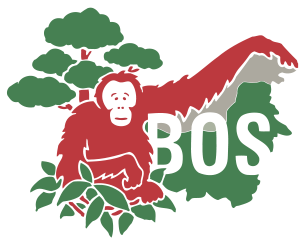Research confirms orangutan population decline
Research paper confirms continuing orangutan population decline
Great Ape Trust of Iowa, July 2, 2008
Data collected with improved assessment tools increase imperative for island-specific conservation action plans
Endangered wild orangutan (Pongo spp.) populations are declining more sharply in Sumatra and Borneo than previously estimated, according to new findings published this month by Great Ape Trust of Iowa scientist Dr. Serge Wich and other orangutan conservation experts in Oryx – The International Journal of Conservation.
Conservation action essential to survival of orangutans, found only on the islands of Sumatra and Borneo, must be region-specific to address the different ecological threats to each species, said Wich and his co-authors, a pre-eminent group of scientists, conservationists, and representatives of governmental and non-governmental groups. They convened in Jakarta, Indonesia, in January 2004 to address the threats to orangutan survival and develop new assessment models to guide conservation planning.
New orangutan population estimates revealed in the July issue of Oryx reflect those improvements in assessment methodology – including standardized data collection, island-wide surveys, and better sharing of data among stakeholders – rather than dramatic changes in the number of surviving orangutans.
The experts’ revised estimates put the number of Sumatran orangutans (P. abelii) around 6,600 in 2004. This is lower than previous estimates of 7,501 as a result of new findings that indicate that a large area in Aceh that was previously thought to contain orangutans actually does not. Since forest loss in Aceh has been relatively low from 2004 to 2008, the 2004 estimate is probably not much higher than the actual number in 2008. The 2004 estimate of about 54,000 Bornean orangutans (P. pygmaeus) is probably also higher than the actual number today as there has been a 10 percent orangutan habitat loss in the Indonesian part of Borneo during that period.
“It is clear that the Sumatran orangutan is in rapid decline and unless extraordinary efforts are made soon, it could become the first great ape species to go extinct,” Wich et al. wrote. “Although these revised estimates for Borneo are encouraging, forest loss and associated loss of orangutans are occurring at an alarming rate, and suggest that recent reductions of Bornean orangutan populations have been far more severe than previously supposed.”
The new numbers underscore important issues in orangutan conservation. With improved sharing of data and deeper collaborations among stakeholders, the experts determined that 75 percent of all orangutans live outside of national parks, which have been severely degraded by illegal logging, mining, encroachment by palm oil plantations and fires due to a general lack of enforcement by regulatory authorities, who are either unable or reluctant to implement conservation management strategies.
However, some recent conservation successes – keyed on political and financial support, media attention and advocacy by conservationists – offer cause for cautious optimism that illegal logging in protected areas can be effectively reduced and improved management of protected areas can be attained, according to the experts.
“It is essential that conservation measures are taken to protect orangutans outside national parks, and these measures will by necessity be specific to each region,” Wich et al. wrote.
The experts reported positive signs that forest conservation is gaining prominence as a political agenda. For example, habitat loss has stabilized in some parts of Sumatra with a temporary logging moratorium in the province of Nanggroe Aceh Darussalam, where most of the island’s orangutans occur, both in and out of national parks. Opportunities also exist to develop reduced-impact logging systems on the island of Borneo, where most orangutans live in forests already exploited for timber.
Although other threats to orangutan survival exist, such as hunting in agricultural areas where human-orangutan conflicts exist, the biggest by far is forest destruction associated with the burgeoning palm oil industry in Indonesia and Malaysia. Together, they are the world’s largest palm oil producers with a combined global market share of 80.5 percent. Rapid expansion of the palm oil industry coupled with poor land-use planning are further pressuring forests and the orangutans who depend on them for survival.
For example, in Sumatra, the controversial Ladia Galaska road project in the Leuser Ecosystem will, unless halted, fragment two of the three largest remaining orangutan populations, Wich et al. wrote. A similar project in 1982 split the Gunung Leuser National Park, and the improved access facilitated uncontrolled illegal settlements inside the park, large-scale illegal encroachment and logging, and poaching of threatened species. Also cited as an example of faulty land-use planning was a mega rice project, funded primarily by Indonesia’s reforestation fund, which eliminated 10,000 square kilometers of peat swamp forest and killed an estimated 15,000 orangutans from 1996 to 1999.
“Both are examples of ill-advised projects with few benefits to local economies but major environmental costs,” Wich et al. wrote. “However, as such projects provide substantial revenue for a small group of individuals with considerable political influence, unprecedented political will is needed to prevent similar projects in the future.”
The experts’ report includes sweeping recommendations for:
* Effective law enforcement and prosecution to stop hunting orangutans for food and trade;
* Mechanisms to mitigate and reduce human-orangutan conflict in agricultural areas, including large-scale plantations;
* The development of an auditing process to assess the compliance of forestry concessions to their legal obligation to ensure orangutans are not hunted in concession areas;
* Increased environmental awareness at the local level, following examples set by the Sumatran Orangutan Conservation Program and the Kinabatangan Orangutan Conservation Project that promote awareness of conservation of forests and the importance of biodiversity;
* Development of mechanisms to monitor orangutan populations and forest cover, building on those in place on both Borneo and Sumatra;
* Continuation of surveys in less explored regions; and
* Continued improvement of survey methodology to include nest-decay rates.
“All efforts to monitor orangutans, however, will be to no avail unless the decline in numbers is halted, and this requires a change in political will,” Wich et al wrote. “It is essential that funding for environmental services reaches the local level and that there is strong law enforcement. Developing a mechanism to ensure these occur is the challenge for the conservation of orangutans.”
Great Ape Trust Director of Conservation Dr. Benjamin Beck said the paper makes a significant contribution to orangutan conservation discussion.
“First, we have an unambiguous, scientifically rigorous answer when regulators and policymakers ask us how many orangutans really remain, and how that compares to historical population sizes,” Beck said. “Those responsible for environmental stewardship cannot hide indecisively behind purported scientific uncertainty.
“Second, those answers are the results of pooled knowledge of nearly two dozen high-profile investigators who set aside their own professional reputations and agendas to collect data in a standardized format and share the results for a very high, common priority: the literal survival of the species that they study and love,” Beck continued. “In addition to being a critical contribution to orangutan conservation, this paper is an exemplar of collaboration among conservation scientists and practitioners.”
Dr. Rob Shumaker, director of orangutan research at Great Ape Trust, said Wich’s paper is historically important and verifies the crisis situation for wild orangutans. “This represents enormous amounts of work from the authors and demonstrates their commitments to the science of orangutan conservation,” he said. “It’s a particularly notable achievement for Dr. Wich and continues his extraordinary dedication to the study of orangutans.
“It is my fervent hope that these data inspire action on the part of everyone who can positively affect orangutan conservation.”
In addition to his responsibilities at Great Ape Trust, Wich is co-manager of orangutan research at Sumatra’s Ketambe Research Center, one of the longest-running orangutan field study sites in the world.
His co-authors in the latest publication in Oryx, “Distribution and conservation status of the orangutan (Pongo spp.) on Borneo and Sumatra: How many remain?”, are:
* Erik Meijaard, Orangutan Conservation Services Program, Balikpapan, Indonesia, and Tropical Forest Initiative, The Nature Conservancy, Balikpapan, East Kalimantan, Indonesia;
* Andrew J. Marshall, Department of Anthropology and Graduate Group in Ecology, University of California, Davis, U.S.A.;
* Simon Husson, Wildlife Research Group, Department of Anatomy, University of Cambridge, U.K.;
* Marc Ancrenaz, Kinabatangan Orangutan Conservation Project, Sandakan, Sabah, Malaysia;
* Robert C. Lacy and Katy Traylor-Nolzer, IUCN (World Conservation Union)/SSC (Species Survival Commission) Conservation Breeding Specialist Group, Apple Valley, Minn., U.S.A.;
* Carel P. van Schaik, Anthropological Institute & Museum, University of Zurich, Switzerland;
* Jito Sugardjito, Fauna & Floral International – Indonesia Programme, Kompleks Pusat Laboratorium UnivNasional, Ragunan, Jakarta, Indonesia;
* Togu Simorangkir, Yayorin (Yayason Orangutan Indonesia), Pangkalan Bun, Central Kalimantan, Indonesia.
* Matt Doughty, United Nations Environment Programme – World Conservation Monitoring Centre, Cambridge, U.K.
* Jatna Supriatna, Conservation International – Indonesia Programme, Jalan Pejaten Barat, Kemang, Jakarta, Indonesia.
* Rona Dennis, Center for International Forestry Research, Bogor, Indonesia;
* Melvin Gumal, Wildlife Conservation Society-Malaysia, Kuching, Sarawak, Malaysia;
* Cheryl D. Knott, Harvard University, Department of Anthropology, Peabody Museum, Cambridge, U.S.A.; and
* Ian Singleton, Sumatran Orangutan Conservation Programme, Medan, Indonesia.




